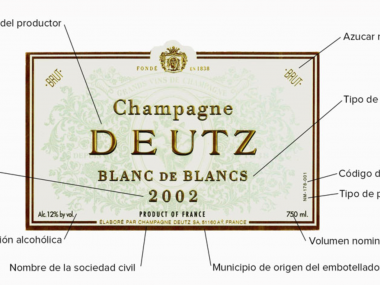Cabernet Sauvignon is considered one of the most famous red grape varieties in the world. Here we answer the most frequent questions about it, from its particular characteristics, its primary flavors, its ideal pairings and how to drink these wines.
The red wine grape Cabernet Sauvignon is a natural cross between Cabernet Franc and Sauvignon Blanc from Bordeaux, France. This variety is especially valued for its high concentration of flavor and ripeness. It produces full-bodied wines with medium to high levels of tannins and alcohol content.
Where does the Cabernet Sauvignon variety come from?
The Cabernet Sauvignon variety comes from the French department of Gironde, located in the southwest of France (Aquitaine region). It is a vigorous variety with a late budding and medium-late maturation.
Moreover, it adapts very well to gravelly and well-drained soils, preferably with an acidic PH. It is very susceptible to fungal diseases affecting the wood such as tinder and euthypiosis and also to powdery mildew.
It can also be susceptible to drying out of the stems. Its clusters and berries are small, thick skinned and bluish in tone. The vine shoots are hard which makes it suitable for mechanical harvesting and at the same time protects it from spring frosts.
The Cabernet Sauvignon variety is the dominant grape in the coupages of the most famous wines of the Médoc and Graves regions in Bordeaux. In the 20th century, the fashion to grow international varieties exploded and Cabernet Sauvignon was the star variety.
What are the main characteristics of the Cabernet Sauvignon variety?
The Cabernet Sauvignon variety is characterized by its powerful character and its ability to be kept in red wines. Thanks to its small berries and thick skin, Cabernet Sauvignon wines tend to be deep in color, high in tannin and relatively high in acidity.
In turn, Cabernet Sauvignon wines tend to be noble and the aromas can vary from blackcurrant to cedar; although such is their affinity with oak that in young wines it can be difficult to dissociate the fruit from the wood.
The high concentration of tannins in Cabernet Sauvignon wines means that the wines last for decades, occasionally centuries, and may need a long time in the bottle before consumption to round out the tannins.
Unless the Cabernet Sauvignon variety is very ripe, it tends to produce wines with a long-lasting structure but somewhat shorter in fruit, so it has traditionally been blended with Merlot to give the wine a fruity and smooth character.
The most remarkable thing about Cabernet Sauvignon is its identity in any wine in which it participates, even if the amount contributed is minimal, nevertheless it only produces great wines in a few regions.
How should Cabernet Sauvignon wines be consumed?
Ideally, Cabernet Sauvignon wines should be served at 15-20°C. It is also recommended to use a wide glass. If a decanter is used, it is best to let the wine rest for an hour. As for the time it can remain in the cellar, we can start counting from ten years onwards.
What foods should be paired with them?
Their rich, intense and particular flavor, with a high content of tannins, make these wines the perfect combination for roasted meats, spicy sauces, and in general very tasty and strong dishes.
Which are the regions where the best examples of Cabernet Sauvignon are produced?
The regions where the best examples of Cabernet Sauvignon red wines are produced are Médoc, Pessac-Léognan, Penedés, Napa Valley, Bolgheri, Sonoma, Santa Cruz Mountains, some parts of Washington State, Chile, Coonawarra and Margaret River in Australia.
In Spain the Cabernet Sauvignon variety was introduced in the mid 19th century by the Marqués de Riscal in La Rioja and Eloy Lecanda de Vega Sicilia in Ribera del Duero, but it was Miguel Torres and Jean Leon in the 1960s who encouraged Spanish wine producers to value this queen variety.
Torres Mas La Plana 1970 was among the best wines in the execution of the famous 1976 judgment comparing blind tasting in Paris of French wines and those from other wine-growing areas.
In 2008, Cabernet Sauvignon was the fourth most widely planted variety of red wine in Spain. It is particularly popular in the north, in the Navarra and Somontano designations of origin, as well as in La Mancha, Ribera del Duero, Andalucia and Priorat.






